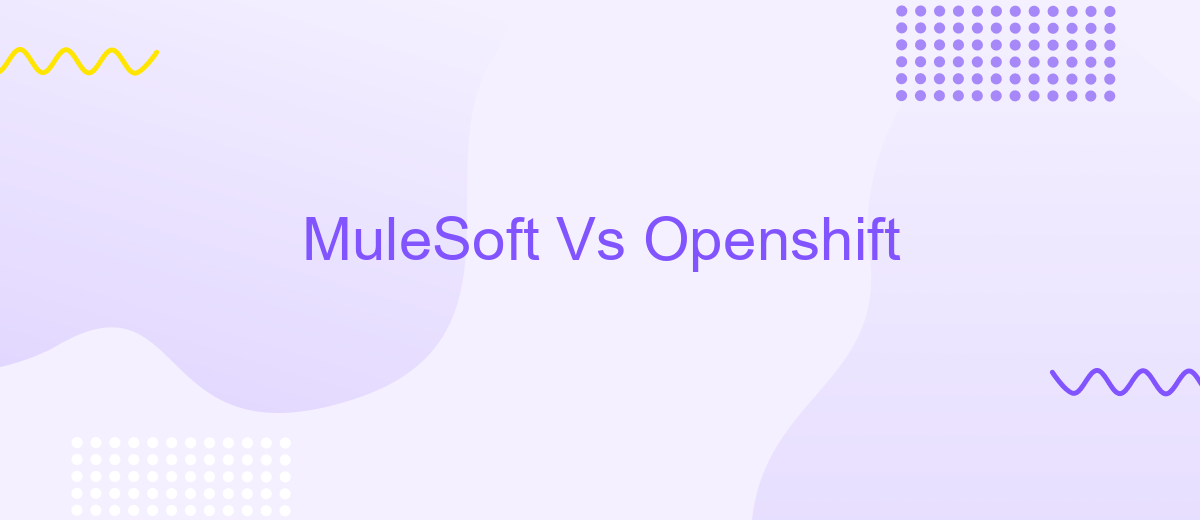MuleSoft Vs Openshift
In today's rapidly evolving tech landscape, businesses are constantly seeking robust integration and deployment solutions. MuleSoft and OpenShift stand out as two prominent platforms catering to these needs. While MuleSoft excels in API management and integration, OpenShift offers a powerful container orchestration and application development environment. This article delves into their key features, advantages, and potential use cases to help you make an informed decision.
Introduction
In today's rapidly evolving technological landscape, businesses are increasingly seeking robust solutions to streamline their operations and enhance productivity. MuleSoft and OpenShift have emerged as two prominent platforms that cater to these needs, each offering unique capabilities and advantages. MuleSoft is renowned for its comprehensive integration platform that connects various applications, data, and devices, while OpenShift is a powerful Kubernetes platform designed for container orchestration and management.
- MuleSoft: A leading integration platform for seamless connectivity.
- OpenShift: A robust Kubernetes platform for containerized applications.
- ApiX-Drive: An efficient tool for automating integrations and workflows.
Choosing between MuleSoft and OpenShift depends on the specific requirements and goals of your organization. While MuleSoft excels in providing a unified integration experience, OpenShift offers unparalleled flexibility and scalability for managing containerized environments. Additionally, tools like ApiX-Drive can further simplify the integration process, making it easier to automate workflows and enhance operational efficiency. Understanding the strengths and limitations of each platform is crucial for making an informed decision that aligns with your business objectives.
MuleSoft Overview

MuleSoft is a leading platform for building application networks that connect enterprise apps, data, and devices. It provides a comprehensive suite of tools, including Anypoint Platform, which allows businesses to design, build, and manage APIs and integrations. MuleSoft's robust capabilities enable organizations to create seamless workflows and enhance operational efficiency by ensuring that disparate systems can communicate effectively.
One of the key features of MuleSoft is its ability to streamline integration processes, making it an invaluable tool for enterprises looking to modernize their IT infrastructure. Additionally, services like ApiX-Drive can complement MuleSoft by offering easy-to-use, no-code solutions for integrating various applications and services. This synergy allows businesses to automate workflows and reduce the time and resources required for integration projects, ultimately driving innovation and growth.
OpenShift Overview

OpenShift is a comprehensive Kubernetes platform developed by Red Hat that provides a robust framework for building, deploying, and managing containerized applications. It offers a range of tools and services to streamline the development process, ensuring that applications can be easily scaled and maintained. OpenShift supports both stateful and stateless applications, making it a versatile choice for various enterprise needs.
- Integrated Developer Tools: OpenShift includes a suite of developer tools that enable seamless integration and continuous delivery, enhancing productivity and collaboration.
- Automated Operations: It automates many operational tasks, such as scaling, monitoring, and updates, reducing the operational burden on IT teams.
- Hybrid Cloud Support: OpenShift can be deployed on-premises, in the cloud, or in hybrid environments, providing flexibility and scalability for diverse deployment scenarios.
OpenShift also integrates well with various third-party services, including ApiX-Drive, which simplifies the process of setting up integrations with other platforms and applications. This capability is particularly useful for businesses looking to automate workflows and enhance data connectivity across their IT ecosystem. With its robust features and flexibility, OpenShift is a powerful solution for modern application development and deployment.
Comparison Table

When comparing MuleSoft and OpenShift, it's essential to understand their core functionalities and how they cater to different needs. MuleSoft is primarily an integration platform that allows businesses to connect various applications, data, and devices. On the other hand, OpenShift is a comprehensive container platform that helps in deploying and managing containerized applications.
Both platforms offer unique features that can significantly benefit organizations, depending on their specific requirements. While MuleSoft excels in seamless integrations, OpenShift provides robust support for container orchestration and management.
- Core Functionality: MuleSoft (Integration) vs. OpenShift (Container Management)
- Ease of Use: MuleSoft (User-friendly) vs. OpenShift (Requires DevOps expertise)
- Scalability: MuleSoft (Scalable integrations) vs. OpenShift (Scalable container deployments)
- Third-Party Integration: MuleSoft (Extensive) vs. OpenShift (Moderate)
- Support: MuleSoft (Comprehensive) vs. OpenShift (Community and Enterprise)
For businesses looking to streamline their integration processes, services like ApiX-Drive can complement MuleSoft by providing additional automation capabilities. Meanwhile, OpenShift remains a strong choice for organizations focusing on containerized application management and deployment.
Conclusion
In conclusion, both MuleSoft and OpenShift offer robust solutions for businesses looking to enhance their integration and application deployment capabilities. MuleSoft excels in providing a comprehensive integration platform that streamlines connectivity between various systems, applications, and data sources. Its user-friendly interface and extensive library of connectors make it an ideal choice for enterprises aiming to simplify their integration processes.
On the other hand, OpenShift stands out as a powerful containerization platform that supports the development, deployment, and scaling of applications in a consistent and efficient manner. It provides a solid foundation for DevOps practices and offers a flexible environment for managing containerized workloads. For businesses seeking to combine the strengths of both platforms, services like ApiX-Drive can further enhance their integration capabilities by automating data flows and ensuring seamless connectivity between different systems. Ultimately, the choice between MuleSoft and OpenShift will depend on specific business needs and the desired level of integration and application management.
FAQ
What is the primary difference between MuleSoft and OpenShift?
Can MuleSoft and OpenShift be used together?
Which platform is better for API management?
How do MuleSoft and OpenShift handle scalability?
Is there a service to help with the automation and integration setup for these platforms?
Apix-Drive is a universal tool that will quickly streamline any workflow, freeing you from routine and possible financial losses. Try ApiX-Drive in action and see how useful it is for you personally. In the meantime, when you are setting up connections between systems, think about where you are investing your free time, because now you will have much more of it.

